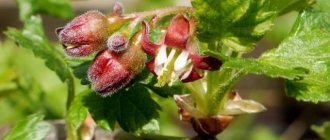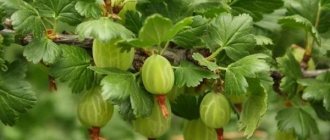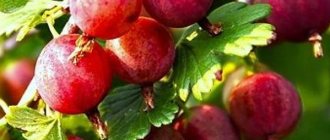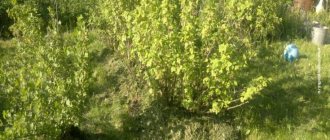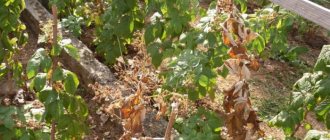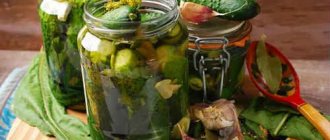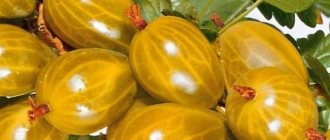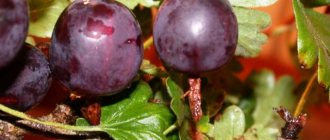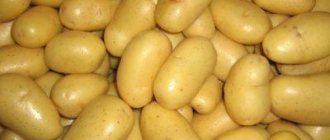Introduction
Finnish gooseberry: photo of variety
Gooseberries are a crop that gardeners have adapted to grow even in the harshest climates. This became possible after hybrid varieties were developed. They are rightfully considered real works of art, especially the Finnish gooseberry. The bulk of modern varieties were created at the beginning of the last century. But then the plants were not so stable and not so hardy. They often got sick and became infected with fungal diseases. And all this played a very cruel joke on them. Thus, breeders set themselves many tasks. One of them is to achieve special varieties that will be as resistant to various infectious diseases as possible. And also to low or too high temperatures.
Finnish gooseberry is a variety that fully meets these requirements. And also to the wildest expectations of gardeners themselves. And both experienced ones and those who are just starting to garden. The Finnish gooseberry variety is a high-yielding species. Thanks to its high immunity, it can be cultivated in literally any area. And with harsh, and with moderate and, of course, with hot climates.
In this article we will dwell in more detail on the description of the Finnish gooseberry variety. We will also tell you about the features of the species. You will also find tips on how best to plant and care for the plant. And how to deal with pests that can periodically infect gooseberry crops.
Reproduction
Finnish gooseberry variety belongs to varieties of crops that reproduce well by vegetative methods.
To root the cuttings, select a two-year-old elastic shoot and place it in a furrow. They are fixed with staples and covered with loose soil on top. The soil is kept moist, and the emerging shoots are lightly hilled. They are separated for transplantation only when young seedlings have developed a developed root system. Most often in the spring of the next year after instillation.
The cuttings method gives a lower survival rate, but it is also often used when a lot of planting material is needed. Cuttings are cut from green, strong shoots in early June. The length of each cutting is about 15 cm. The cuttings are planted in a greenhouse or greenhouse; you can use a homemade greenhouse from a five-liter water bottle.
Finnish gooseberry: variety description
Finnish gooseberry: photo
Finnish gooseberry is a plant that is represented by several main varieties. Basically, they differ from each other in the color of the berries. The classic Finnish gooseberry variety with green berries was the very first to be created. And based on it, varieties were bred whose berries were either yellow or red. One way or another, except for the color of the fruits, they are almost indistinguishable from each other. Including varietal characteristics and taste properties.
All of them belong to the Finnish gooseberry, which has a medium-late fruiting period. The berries ripen even before frost sets in. They are quite simple to assemble. They keep well. And can withstand long-distance transportation. Basically, the shrub is recommended to be grown in the European part of Russia, in the very center. Finnish gooseberry is also a very popular crop among gardeners in Siberia, the Urals and in the Moscow suburbs.
Finnish gooseberry: photo
In general, the characteristics of the Finnish gooseberry can be summarized into several key indicators, each of which reflects specific traits and features. These include the following:
- The plant is medium-sized. It can reach from one to one and a half meters in height. The bushes themselves are very neat and not spreading. They can be formed by numerous upright shoots. This gives the shrub a very attractive and decorative appearance. The stems are perennial and dark gray in color. They may also have a brownish tint. If we are talking about younger shoots, then they look much fresher - light green, neat shoots.
- thorns are located on the branches along their entire length. They grow mainly at an angle of 90 degrees and are quite thick. It is necessary to harvest the crop very carefully to avoid injury. Therefore, thorns can often become a real obstacle to picking ripe berries.
- The deciduous cover of the bushes is very dense. Leaves can form from 4 to 6 pieces at the end of each cutting. The leaf blade as a whole is quite typical in appearance, as for any other gooseberry plant. They are dark green, quite wide, and have wavy edges. By the way, many gardeners also then use the leaves to prepare some dishes, mainly for canning.
- When they bloom, the flowers are quite small, green in color with a slight yellowish tint. They are formed in the form of a cone. Inflorescences can be found on every leaf node. The plant also belongs to the dioecious category.
- the fruits, when they set and develop, acquire a round shape. Their surface is smooth. And the color, as we indicated earlier, completely depends on what variety the plant belongs to. A light waxy coating may be found on the berries, as well as slight pubescence. The pulp inside is very juicy and dense. Small seeds can be found in it. The weight of one berry varies from 4 grams to seven grams. It all depends on what care the gardener himself provides to the plant. And also in what climatic conditions does it grow. By the way, it is worth noting that Finnish gooseberries have a superficial root system. Therefore, after planting, the soil should be cultivated and moistened very carefully.
Characteristics and description of bushes
Gooseberry bushes are medium-sized, reach a maximum height of 1.3 m, compact, not spreading. Mature stems are dark gray with a brown tint. Thick thorns are located along the entire length of the branches at an angle of 90°.
Each bush has dense foliage. The plant blooms in May. The flowers are small, yellow-green in color. The fruits are round in shape, with a smooth surface. The color of the berries depends on which subspecies the bush belongs to.
Temperature resistance
Finnish gooseberries were bred to be resistant to adverse conditions. This is a winter-hardy variety that grows successfully even in regions with short summers and long, harsh winters. It can withstand frosts down to -38°C. Moreover, it does not need to be additionally covered before the onset of frost. Even if the shoots are damaged, they recover in one season. Since flowering occurs late, the flowers are not susceptible to frost. They do not fall off prematurely, and the yield is not reduced because of this.
Moisture and drought resistance
When choosing a place for gooseberries, make sure that groundwater is not located too close to the surface. The optimal depth is 5-6 m. The soil should not be too damp, otherwise the roots of the bush will rot.
But at the same time, gooseberries do not tolerate a lack of moisture. In dry summers, the bushes are watered so that the yield does not decrease, otherwise the berries will grow small and sluggish.
Resistance to diseases and pests
Finnish gooseberries rarely get sick. It has high resistance to pests and diseases, especially powdery mildew and spheroteca. However, this variety is susceptible to anthracnose and septoria.
Green Finnish gooseberry: variety description
Green Finnish gooseberry: photo of variety
Finnish green gooseberry grows to approximately 120 centimeters. Its crown is quite compact. It blooms every year, producing abundant and very attractive blooms. As a rule, Finnish gooseberries begin to bloom around the end of May. After the frosts no longer return, and there is no such threat anymore. Productivity is high. With good care, you can harvest up to 8 kilograms of fruit from one green Finnish gooseberry bush.
The berries of the Green Finnish gooseberry are oval. They have a beautiful light green color. The pubescence of the fruit is weak, the weight of one berry reaches eight grams. The peel is very dense, but thin. And the pulp is very juicy. Inside you can find a certain number of small brown seeds. The leaves on the bush are dull and dark green. But their dullness does not mean that the plant is more or less infected with parasites. This is just a feature of the variety. And the gardener needs to take it into account so as not to take unnecessary measures to fertilize the Green Finnish gooseberry and the soil around it.
Method of use
It is recommended to harvest from the Finnish gooseberry bush in the second or third years of its life. Usually the berries are eaten fresh, but if desired, gooseberries can also be cooked. So, from the crop you can get aromatic and healthy jam, which, due to its high content of vitamin C, can serve as a means of preventing colds in children and adults. They make compotes from gooseberries, make marshmallows and marmalade.
Follow all the recommendations of experts, and large gooseberries will grow at your summer cottage, delighting with their taste, also suitable for long-term frozen storage in winter and various types of preservation.
Yellow Finnish gooseberry: variety description
Yellow Finnish gooseberry: photo of variety
The next variety we will look at is the Finnish Yellow Gooseberry. It was bred specifically for cultivation in northern regions with a very harsh cold climate. In general, among all Finnish varieties, it is the Yellow Finnish gooseberry that has the most pronounced aroma and taste. Which, of course, acts as an advantage of this very variety.
The bush is quite dense, usually no more than one meter in height. It can give very good growth if you properly care for it and provide all the favorable conditions. The berries of the Finnish Yellow gooseberry are round. They have a pleasant amber color. The weight of one berry varies from three to 3.5 grams. You can find two to three berries on the fruit cluster. The pulp is very juicy. In addition to the typical gooseberry flavor, it also gives off an apricot flavor.
How to plant
The quantity and quality of the harvest depends on correctly performed agricultural techniques.
Selecting a location
A well-lit place in the sun is allocated for the culture. Groundwater should not lie higher than 1 meter to the ground surface. When planted along a wall or fence, the shrubs will be well protected from cold winds.
Soil requirements
The culture prefers to grow on loose, loamy soils with a neutral acidity level. Acidic soil is alkalized using dolomite flour, lime, and wood ash. Nutrients are added to depleted soils.
Recommendations for choosing deadlines
Finnish gooseberries can be planted in spring and autumn. Spring planting is preferred in the northern regions so that the seedlings have time to take root before the onset of cold weather. In the southern regions, autumn planting of the crop is common.
Site preparation
The planting area is cleared of debris in advance and dug up. Add a bucket of compost, a glass of wood ash, and 3 tablespoons of nitrophoska to the infertile soil. The indicated ingredients are added per square meter of area.
How to choose planting material
The stems of seedlings should be strong, elastic, without stains or scratches. The root system of a healthy gooseberry is well developed, without growths and dry parts. For better rooting, seedlings are placed in a bucket with a solution of any growth stimulant for 4-12 hours.
Planting scheme
The procedure for planting Finnish gooseberries is as follows:
- a hole is dug with a diameter and depth of 45×45 centimeters;
- a small layer of drainage is laid on the bottom;
- then nutrient soil is poured;
- A seedling is placed in the middle of the hole and the roots are straightened;
- pour out the remaining substrate;
- compact the soil and water it abundantly.
To preserve moisture, the tree trunk circle is sprinkled with mulch.
Red Finnish gooseberry: description of the variety
Red Finnish gooseberry: photo of variety
In fact, among all the other varieties that we are considering here, Red Finnish gooseberry is the tallest. It can reach one and a half meters. But there is one more feature here. The level of thorniness of these shrubs is also much higher than that of all other varieties. The spines are very thin and long, arched. You can get injured when pruning bushes or harvesting crops. So you should be careful and careful and wear gloves.
Gooseberries of the Finnish Red variety have a round shape. Very large - the weight of one berry reaches nine grams. The pulp has a purple hue, very dense and juicy. In fact, it is the red gooseberry that is the most productive among all other varieties. Because the yield from one bush of Finnish Red gooseberry sometimes reaches as much as eleven kilograms. And this is truly a record figure among all other varieties. Therefore, other breeding experimenters have room to strive.
Reviews
I planted the “Finnish” gooseberry only 2 years ago, but this year there was already fruiting and quite abundantly. From each bush I collected about a bucket (5 liters) of berries. I planted this variety mainly for its color. I have several bushes of dark gooseberries, I wanted to diversify and plant yellow ones. I remember my mother had 2 bushes with light berries in her garden, I remember the sweet taste and thin skin, this year, one might say, I tasted the taste of childhood again. So far I’m happy with everything: the bush is compact, there’s nowhere to plant giants in my small garden, the fruits are delicious. It’s too early to talk about winter hardiness, but the bush survived 2 winters without shelter and did not freeze.
I make wine from Finnish gooseberries. It turns out to be a very beautiful sunny color. The drink is aromatic and moderately sweet.
If you follow simple recommendations for growing Finnish gooseberries, you will be able to get a decent harvest of berries that taste great. It is important that this culture adapts well to conditions with a changeable climate.
Finnish gooseberry: features of all varieties
Finnish gooseberry: photo of variety
Now it is important to analyze what the main features of the Finnish variety as a whole are, which will also apply to the individual green, yellow and red varieties of this crop.
Many experienced gardeners use Finnish laceberry varieties. Because these crops very rarely get sick. They have a fairly high frost resistance. They also differ in that they have a stable level of fruiting. This means that regardless of weather and other conditions, the bush will still produce a bountiful harvest. In accordance with the characteristics and volumes that were indicated in the previous part of our article.
All varieties of Finnish gooseberries are quite stress-resistant. They have a high level of immunity. They are also distinguished by the fact that they are not capricious in care and are unpretentious. And they are adapted to unfavorable conditions, if suddenly there is no stability in the region where the plant grows.
Varieties of Finnish gooseberries were specially bred so that the bushes could grow safely. And bear fruit even in those areas where there are long winters or a short summer period. Gooseberries tolerate a drop in air temperature to -38 degrees absolutely calmly. You don’t even have to cover it with anything extra. If suddenly the shoots are damaged, the bush can completely recover in one season. At the same time, the level of fruiting will not decrease in any way. And this is a huge positive moment. Flowering occurs relatively late. The flowers are also not affected by frost and do not fall off.
Light-loving, productive gooseberry variety Finnish
Distinctive features of the variety
First of all, this variety produces a generous harvest if the farmer provides proper care for the plant. This gooseberry will take root well even in areas with cold winters, as it can withstand even severe frosts. As for diseases, the plant is characterized by the greatest resistance to powdery mildew.
What other points should a gardener who decides to cultivate the Finnish variety on his plot know about? The bushes grow slightly spreading and not too tall. The shape of the leaf blade is oval, and the color is a dark shade of green. This plant blooms in May.
If you grow the shrub properly in your garden, you will end up with yellow berries with thin skin. Their taste deserves special attention: every gooseberry lover will appreciate the pronounced sweetness with a slight sourness. You can harvest a full harvest by mid-summer, since this species belongs to the mid-season varieties of berry bushes.
Remember: having planted seedlings in open ground, you will not taste these nutritious berries in the first year. Moreover, some experts recommend cutting off flowers and ovaries altogether during the first spring-summer season so that the bush can take root well and not waste energy on ripening the fruits. But gooseberries begin to actively bear fruit already in the second or third year after planting.
Planting and care
Like most gooseberry varieties, the variety called Finnish gooseberry is planted both in autumn (late September) and spring (before similar shrubs begin to bloom). In order for the soil work you have carried out to be effective, soak the root system of the seedlings in a special solution - a growth stimulator - for at least a day. In this case, the plant will begin to take root and grow much more intensively.
How is this gooseberry planted? Everything is quite simple. You need to dig holes in the area you have chosen. If you have already applied fertilizers to open ground in the fall, it is not necessary to add them directly during the planting process.
Remember also that after you have placed the seedlings in the holes, you need to carefully and carefully straighten their root system, and then gradually cover it with soil, not forgetting to water it with water. This procedure must be done gradually so that the soil is compacted and there are no gaps left between the balls of soil.
What is the process of caring for Finnish gooseberries? This is a set of basic agricultural techniques that almost every gardener knows about. First of all, rooted seedlings need to be watered from time to time. It is also very important to loosen the soil circle around the bushes and remove weeds. A separate, but no less important stage in providing complete care for berry bushes is protecting the plant from all kinds of diseases and pests.
Selection of location and soil
What every gardener should worry about in advance is not only about purchasing high-quality gooseberry varieties, but also about choosing the right site for planting them. What should you consider first? To begin with, try to determine a well-lit place for the gooseberry seedlings and protected from the winds.
The bushes of this plant can be safely planted even near a hedge. Another important point: the soil should be well fertilized, but not too wet. If the root system of a shrub is constantly damp, it will simply begin to rot.
Sometimes choosing a place for gooseberries becomes a whole problem for the farmer. And all because not all summer cottages have enough space for bushes. If you have the same situation, you can plant gooseberry bushes between fruit trees. However, remember that the plant must have access to sunlight, otherwise all your efforts may be in vain.
Watering and fertilizing
It is advisable to be careful when moistening the soil circle near Finnish gooseberry bushes. It is very important that the groundwater does not pass too high, otherwise your plant will not be able to develop fully. As for fertilizing, it is not enough to apply fertilizer in the fall in the process of preparing the site for planting gooseberry bushes.
Foliar feeding is another key point. Here it is necessary to follow some rules, and add nutrient mixtures to the soil not randomly, but using some system, which includes the following steps:
- The first feeding is carried out at the time when the first leaves begin to form on the bush. The solution must include urea and nitrophoska;
- the second stage must be carried out during the flowering of the bush. Potassium sulfate and special fertilizers for gooseberries can be used as a nutrient mixture;
- The third feeding will be needed by the plant during the period of active energy expenditure (during fruit formation). Nitrophoska and potassium humate are the key components of the next vitamin solution.
Carry out all stages of fertilizing shrubs correctly - and you will get good results.
Trimming
To begin with, pruning is carried out so that the young shrub is formed correctly. But after the first three years of cultivating the plant in your summer cottage, the main purpose of pruning becomes to reduce density. At the same time, do not forget to remove old and dry branches, broken and damaged shoots.
Follow the key rule: branches that are more than 5-6 years old will no longer be able to bear fruit fully, so they can be removed without regret. Some farmers prune shoots not only in early spring or late autumn, but also in the summer. They cut off the tops of green shoots so that large berries can form on the bush.
Yield indicators
Finnish gooseberry variety will be the best choice for gardeners who plan to cultivate this plant in temperate climatic conditions. It tolerates winter well with its excessive frosts, and is also tolerant of drought in summer. As for the volume of harvest, this plant is considered medium-yielding. However, if you provide proper care for the bush, you will be able to harvest quite large berries as a result.
Follow the basic recommendations from experts - and this kind of shrub will be the best choice for you. Grow large and nutritious gooseberries on your plot, which in the future can not only be eaten fresh, but also used to prepare various dishes.
Flowering and fruiting
The number of ovaries largely depends on the amount of flowering. And the abundance of Finnish gooseberries is always excellent. As for drought resistance, in this case it is rather average than high. If the plant is experiencing moisture deficiency, this may adversely affect the quality of the fruit. And also on their taste properties. The berries become much smaller and wither. And the taste is more sour than sweet, as is usually the case. The leaves also become very dull and may turn yellow. Vegetation processes are becoming slower. There is no sap flow and formation of minerals. If climatic conditions exclude regular precipitation, then it is best to water the bush as often as possible.
Finnish gooseberry produces both female and male flowers. The variety is self-pollinating. Therefore, it is not necessary to plant any other plants next to the bush so that they pollinate the Finnish bush. Flowering begins around the end of May. And you can start picking berries as early as August. Fruiting occurs approximately in the fourth year after the shrub was planted in open ground. The average is 8 kilograms from one gooseberry bush. And this is a fairly high indicator that needs to be paid attention to.
If the Finnish gooseberry has enough sunny color and moisture, then the fruits are especially sweet and juicy. They do not bake, do not fade and, most importantly, do not fall from the bushes. Even if they have reached their maturity, and the gardener has not yet had time to harvest. The fruit gives off a fairly fresh and pleasant aroma. If the gooseberry experiences an excess of moisture, it may crack. Therefore, you should pay special attention to soil moisture and planting care in general. The peel of the fruit is very dense. The berries can be stored in a suitable place for up to six days. At the same time, they do not lose their mass at all.
Finnish gooseberries can be grown on an industrial scale. It's great for this. Because it can carry transportation over fairly long distances. The berries can be eaten fresh. And also add to some fruit preparations - jams, preserves. Drinks are also prepared from Finnish gooseberries. And the leaves are added to twists for the winter. They are great as an additive to preserves, along with currant leaves.
Main characteristics
Finnish varieties are popular among gardeners. The crop is rarely affected by infection, has a high frost resistance, and is characterized by stable fruiting. All varieties of Finnish gooseberries are unpretentious in care and adapted to adverse weather conditions.
Drought resistance, frost resistance
Finnish gooseberry varieties were created specifically for cultivation in areas with long, cold winters and short summers. Gooseberries safely tolerate temperatures dropping to -38 0C. If the shoots are damaged during the season, the bush is completely restored without loss of fruiting level. The variety blooms relatively late, the flowers are rarely affected by frosts; if return frosts occur at the time of flowering, the gooseberry tolerates down to -4 0C.
The drought resistance of Finnish gooseberry varieties is average. Moisture deficiency affects fruits. The berries grow smaller, flaccid, and the taste is dominated by acid. The leaves lose their bright color, turn yellow, and the growing season slows down. In the absence of precipitation, the crop requires periodic watering.
Fruiting, productivity
Finnish gooseberry produces male and female flowers, and the varieties are self-pollinating. Fruiting is stable every year. The berry bush blooms at the end of May, ripe berries are harvested in August. Mid-late varieties bloom late and ripen in a short time; this feature is relevant for temperate climates. Gooseberries begin to bear fruit in the 4th year of growth, the average yield of Finnish varieties is 8 kg per 1 unit.
The ripening period occurs during high summer temperatures, so it is necessary to observe the irrigation regime. With enough moisture, the berries do not bake or fall off in the sun. A sufficient amount of sugar is accumulated, the taste is balanced with a minimum acid content. Juicy fruits are characterized by a delicate aroma. If there is excess moisture, the berries of Finnish gooseberry varieties are prone to cracking.
The skin of gooseberries is dense, the berries are stored within 6 days without losing weight. Finnish gooseberries are suitable for industrial cultivation and can easily be transported. The berries are consumed fresh or added to fruit jam, such as apple jam.
Advice! Gooseberries can be frozen; they completely retain their taste and chemical composition.
Advantages and disadvantages
Advantages of Finnish gooseberries:
- Fruiting is stable, high, the bush produces berries for more than 10 years;
- high frost resistance;
- strong immunity;
- fruits on a 5-point tasting scale are rated at 4.7 points;
- the berries do not bake, do not crack, and stay on the bush for a long time;
- gooseberries are suitable for growing in regions with cold climates;
- The harvest is stored for a long time and safely transported.
Disadvantages include poor drought resistance and the presence of thorns.
Advantages and disadvantages
Finnish gooseberry: photo
The Finnish gooseberry variety has both its positive and negative sides. Gardeners themselves usually pay attention to them. Since it largely depends on this whether one or another variety will be chosen or not. Among the advantages of Finnish gooseberries, the following should be highlighted:
- stable fruiting, which remains at the same high level both in the fourth year of cultivation and in the tenth;
- high frost resistance;
- high level of bush immunity to various common diseases;
- the taste of fruits on a five-point scale is rated at 4.7 points;
- the berries do not wither or bake, and do not crack. They can stay on the bush for a long time. Even after they have finally ripened, the gardener has not yet had time to remove them from the bush;
- Finnish gooseberries can also be grown in regions with a good climate. And in regions where the climate is unstable, frost may occur;
- the crop can be stored for a long time. And also transport over fairly long distances. This does not in any way affect the taste or external qualities of the fruit. Which is undoubtedly a huge plus.
If we are talking about the disadvantages of the Finnish gooseberry variety, then they include the poor drought resistance of the varieties. And also the fact that the branches of the bush are almost entirely covered with very prominent thorns. This complicates the care of the plant, as well as harvesting. But many gardeners wear gloves when working. And this may go virtually unnoticed. So this disadvantage is rather relative and rather subjective.
Advantages and disadvantages
The advantages of Finnish gooseberries include the following qualities:
- winter hardiness;
- abundant fruiting;
- excellent transportability of fruits;
- good plant immunity;
- high taste qualities of berries.
Disadvantages include: the presence of thorns and poor drought resistance.
Planting Finnish gooseberries
Finnish gooseberries can be propagated in two ways - either generatively or vegetatively. Each method has its own characteristics. And gardeners choose them in accordance with their interests and capabilities. The seed method is used mainly in breeding work. And it helps breeders develop new gooseberry varieties and crops with new characteristics. It is best to propagate gooseberries on the site by cuttings, layering or dividing the bush. This way they get along better. And it is much easier for the gardener to care for the plant. But, again, it all depends on the gardener’s capabilities and his interests in growing the plant.
It is best to plant Finnish gooseberries in the spring, when the soil has already warmed up and there is no threat of return frosts. For central Russia, the average planting time is usually in the fall - in September. Before frost comes, it is better for the bush to take root well so as not to lose vitality and energy.
Choose an open, sunny place for planting; you can choose a place where there will be slight darkness. The soil must be non-acidic and fertile. It should be well ventilated, and moisture should not stagnate inside it. The planting material must have at least two mature stems, leaves and buds. There should be no visible damage on it. The root system should also be without visible deviations or transformations.
Planting Finnish gooseberries is carried out in accordance with the following algorithm:
- before planting, the seedling must be immersed in a growth stimulator for several hours;
- organic matter, sand, peat, soil - all this is mixed, wood ash is also added to the uniform mixture;
- a hole must be dug with a diameter of at least 40x40 centimeters, and the depth must be up to half a meter;
- a drainage layer is lined at the bottom;
- part of the prepared nutrient substrate should be poured directly onto the drainage;
- the bush descends to the very center, the root system straightens out;
- the root system is filled with the remains of the nutrient mixture, the hole is filled to the top with soil, compacted and watered. It is also necessary to cover the root trunk with mulch - sawdust mixed with peat or any other mixtures that are suitable for mulching the soil.
Planting and care
Finnish gooseberries are planted in the spring after the soil has warmed up to +8 0C (approximately in May) and in the fall (30 days before frost). For the middle zone, the autumn planting date is September. Choose a place open to the sun or with periodic shading. The soils are fertile, neutral or slightly acidic, aerated, without excess moisture. Planting material should have 2-3 stems, with leaves and fruit buds, without mechanical damage. The root is well developed, without dry areas.
Planting gooseberries:
- The seedling is immersed in a growth stimulator for 4 hours.
- Mix organic matter, sand, peat, turf soil, and add ash.
- Dig a hole with a diameter of 40*40 cm and a depth of 45 cm.
- The bottom is covered with a layer of drainage (15 cm).
- Pour part of the nutrient substrate onto the drainage pad.
- Gooseberries are placed in the center.
- Cover with the rest of the nutrient mixture.
- The hole is filled to the top with soil.
- Compact, water, cover with mulch.
The root collar remains approximately 5 cm above the surface. After planting, the stems are trimmed, leaving 2 buds on each.
Growing rules
Varieties of Finnish gooseberries bear fruit for about 10 years, so that productivity does not fall, the bush requires care:
- In the spring, gooseberries are fed with nitrogen-containing products, and organic matter is added at the time of fruiting.
- Watering is oriented towards seasonal precipitation; the root ball should not be allowed to dry out or become waterlogged.
- The Finnish gooseberry bush is formed with 10 stems; in the fall, after picking the berries, they are thinned out, leaving strong shoots. In spring, frozen and dry areas are removed.
- To prevent small rodents from damaging the branches, special chemicals are placed around the bush.
Finnish gooseberries have a high frost resistance, so covering the crown for the winter is not required. In autumn, the bush is watered abundantly, hilled up, and the trunk circle is covered with a layer of mulch.
Advice! To prevent branches from breaking under the weight of snow, they are collected in a bundle and secured with rope.
Rules for caring for Finnish gooseberries
There are several rules for growing Finnish gooseberries. They must also be followed in order to obtain a sufficiently successful and productive result. So, in the spring, it is best to feed gooseberries with a product that contains a large amount of nitrogen. When gooseberries begin to bear fruit, it is best to switch to organic fertilizers. Watering should be organized in such a way that there is no excessive waterlogging or excessive dryness. To do this, you should monitor the weather forecast, as this is extremely important. The bush can be shaped; to do this, dry branches and shoots should be pruned, following the technique of sanitary and formative pruning. In order to prevent the branches from falling under attack by small rodents, it is best to place some chemicals around the gooseberry bushes that will repel rodents or completely destroy them.
The Finnish gooseberry variety rarely gets sick. As a rule, both green, yellow, and red gooseberry varieties have a high level of resistance to diseases and pests. Stress resistance and immunity are especially evident in cases where the gardener complies with all agrotechnical rules. For prevention, the bushes are sprayed with Bordeaux mixture; you can also water the bushes with hot water. Thus, the variety is ideal for cultivation in various regions, even those that do not have a stable and suitable climate.
It is necessary to follow the rules of agricultural technology, take into account the characteristics and periods of planting, follow the watering schedule and take into account that in dry weather the plant needs more moisture, otherwise this will affect the quality of the fruit and its taste.
Finnish gooseberries are also periodically treated as preventive measures and fed with the necessary mixtures. Finnish gooseberry: video
Care
In order for the Finnish gooseberry to bear fruit abundantly and efficiently, it requires watering, fertilizing, treatment against diseases and pests, pruning and shaping.
Watering
The culture loves abundant watering. If the summer is dry, the root system of the Finnish gooseberry is watered at least 3 times per season. First, the bushes are watered after flowering, then at the stage of fruit formation, and again after harvesting.
Loosening and weeding
The trunk circle of bushes is loosened to a depth of 5-8 centimeters. The procedure prevents the formation of a crust, which makes it difficult for oxygen to reach the roots. Simultaneously with loosening, weeding is carried out to remove weeds. If this procedure is not carried out, the bushes may become infected with diseases and pests found on the weeds.
Trimming and shaping
In the spring, frostbitten, dry, diseased branches are cut out. In autumn, formative pruning is carried out, in which shoots older than 6 years are removed at the root. By this time, the bush should have 15 trunks, 3 branches from each year of life.
See also
Description of gooseberry variety Northern Captain, planting and care technology
Read
Top dressing
Provided that the bushes are planted in fertile soil, fertilizing begins after 2 years. In the spring, they fertilize mainly with nitrogen, for example, dissolve a spoonful of urea in a bucket of water, and pour the entire volume of the suspension under the bush.
The next feeding is done during the flowering of the planting. During this period, mainly potassium and phosphorus are used. The same composition is applied to the tree trunk after the gooseberries bear fruit.
Preparing for winter
In the southern regions, covering the bushes for the winter is not required, since they can withstand temperatures down to -30°C. Young seedlings are bent to the ground, sprinkled with mulch, and covered with agrofibre. A frame is installed over adult plants growing in the northern zone, with covering material placed on top.
